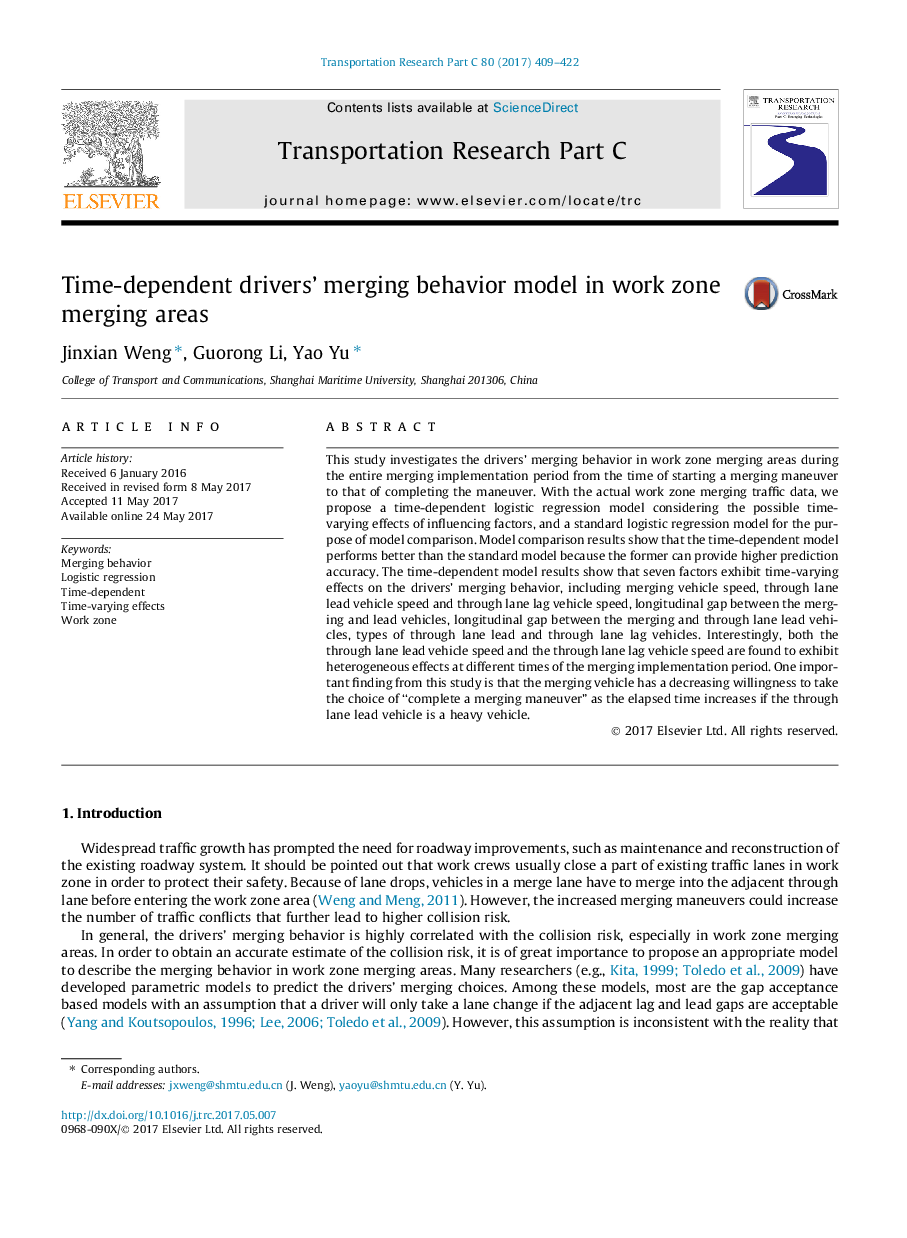| کد مقاله | کد نشریه | سال انتشار | مقاله انگلیسی | نسخه تمام متن |
|---|---|---|---|---|
| 4968454 | 1449668 | 2017 | 14 صفحه PDF | دانلود رایگان |
عنوان انگلیسی مقاله ISI
Time-dependent drivers' merging behavior model in work zone merging areas
ترجمه فارسی عنوان
مدل رفتار ادغام رانندگان وابسته به زمان در مناطق ادغام منطقه کار
دانلود مقاله + سفارش ترجمه
دانلود مقاله ISI انگلیسی
رایگان برای ایرانیان
کلمات کلیدی
ادغام رفتار، رگرسیون لجستیک، وابسته به زمان، اثرات متغیر زمان منطقه کاری،
ترجمه چکیده
در این تحقیق رفتار ادغام رانندگان در مناطق ادغام منطقه کار در طول دوره پیاده سازی ادغام از زمان شروع مانور ادغام به تکمیل مانور بررسی شده است. با داده های ترافیک ادغام شده در منطقه واقعی، ما یک مدل رگرسیون منطقی وابسته به زمان را با توجه به اثرات متغیر ممکن تأثیر عوامل و یک مدل رگرسیون لجستیک استاندارد برای مقایسه مدل پیشنهاد می کنیم. نتایج مقایسه مدل نشان می دهد که مدل وابسته به زمان بهتر از مدل استاندارد عمل می کند، زیرا اولین می تواند دقت پیش بینی پیش بینی را فراهم کند. نتایج مدل وابسته به زمان نشان می دهد که هفت عامل اثرات متغیر زمان بر رفتار ادغام رانندگان، از جمله ادغام سرعت وسیله نقلیه، از طریق سرعت خط رهبری لاین و از طریق سرعت مسیر خودرو عقب، شکاف طولی بین وسایل نقلیه ادغام شده و سرب، فاصله طولی بین وسایل نقلیه سربی ادغام شده و از طریق خط، انواع سرنشین خط و از طریق وسایل نقلیه عقب. جالب توجه است، هر دو مسیر عبور از طریق خط سرعت خودرو و سرعت خطای ناگهانی خطا نشان می دهد اثرات نامتقارن را در زمان های مختلف دوره پیاده سازی ادغام نشان می دهد. یکی از یافته های مهم این مطالعه این است که خودروی ادغام شده تمایل کمتری به انتخاب یک مانور ادغام دارد؟ به عنوان زمان گذشت زمان افزایش می یابد اگر وسیله نقلیه سرنشین وسیله نقلیه سنگین باشد.
موضوعات مرتبط
مهندسی و علوم پایه
مهندسی کامپیوتر
نرم افزارهای علوم کامپیوتر
چکیده انگلیسی
This study investigates the drivers' merging behavior in work zone merging areas during the entire merging implementation period from the time of starting a merging maneuver to that of completing the maneuver. With the actual work zone merging traffic data, we propose a time-dependent logistic regression model considering the possible time-varying effects of influencing factors, and a standard logistic regression model for the purpose of model comparison. Model comparison results show that the time-dependent model performs better than the standard model because the former can provide higher prediction accuracy. The time-dependent model results show that seven factors exhibit time-varying effects on the drivers' merging behavior, including merging vehicle speed, through lane lead vehicle speed and through lane lag vehicle speed, longitudinal gap between the merging and lead vehicles, longitudinal gap between the merging and through lane lead vehicles, types of through lane lead and through lane lag vehicles. Interestingly, both the through lane lead vehicle speed and the through lane lag vehicle speed are found to exhibit heterogeneous effects at different times of the merging implementation period. One important finding from this study is that the merging vehicle has a decreasing willingness to take the choice of “complete a merging maneuver” as the elapsed time increases if the through lane lead vehicle is a heavy vehicle.
ناشر
Database: Elsevier - ScienceDirect (ساینس دایرکت)
Journal: Transportation Research Part C: Emerging Technologies - Volume 80, July 2017, Pages 409-422
Journal: Transportation Research Part C: Emerging Technologies - Volume 80, July 2017, Pages 409-422
نویسندگان
Jinxian Weng, Guorong Li, Yao Yu,
